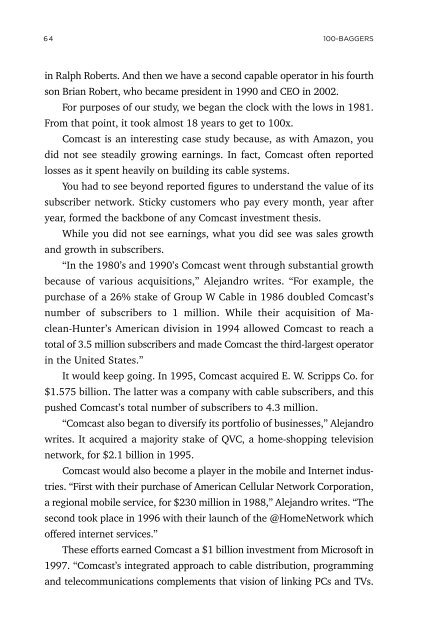You also want an ePaper? Increase the reach of your titles
YUMPU automatically turns print PDFs into web optimized ePapers that Google loves.
64<br />
100-BAGGERS<br />
in Ralph Roberts. And then we have a second capable operator in his fourth<br />
son Brian Robert, who became president in 1990 and CEO in 2002.<br />
For purposes of our study, we began the clock with the lows in 1981.<br />
From that point, it took almost 18 years to get to 100x.<br />
Comcast is an interesting case study because, as with Amazon, you<br />
did not see steadily growing earnings. In fact, Comcast often reported<br />
losses as it spent heavily on building its cable systems.<br />
You had to see beyond reported figures to understand the value of its<br />
subscriber network. Sticky customers who pay every month, year after<br />
year, formed the backbone of any Comcast investment thesis.<br />
While you did not see earnings, what you did see was sales growth<br />
and growth in subscribers.<br />
“In the 1980’s and 1990’s Comcast went through substantial growth<br />
because of various acquisitions,” Alejandro writes. “For example, the<br />
purchase of a 26% stake of Group W Cable in 1986 doubled Comcast’s<br />
number of subscribers to 1 million. While their acquisition of Maclean-Hunter’s<br />
American division in 1994 allowed Comcast to reach a<br />
total of 3.5 million subscribers and made Comcast the third-largest operator<br />
in the United States.”<br />
It would keep going. In 1995, Comcast acquired E. W. Scripps Co. for<br />
$1.575 billion. The latter was a company with cable subscribers, and this<br />
pushed Comcast’s total number of subscribers to 4.3 million.<br />
“Comcast also began to diversify its portfolio of businesses,” Alejandro<br />
writes. It acquired a majority stake of QVC, a home-shopping television<br />
network, for $2.1 billion in 1995.<br />
Comcast would also become a player in the mobile and Internet industries.<br />
“First with their purchase of American Cellular Network Corporation,<br />
a regional mobile service, for $230 million in 1988,” Alejandro writes. “The<br />
second took place in 1996 with their launch of the @HomeNetwork which<br />
offered internet services.”<br />
These efforts earned Comcast a $1 billion investment from Microsoft in<br />
1997. “Comcast’s integrated approach to cable distribution, programming<br />
and telecommunications complements that vision of linking PCs and TVs.


